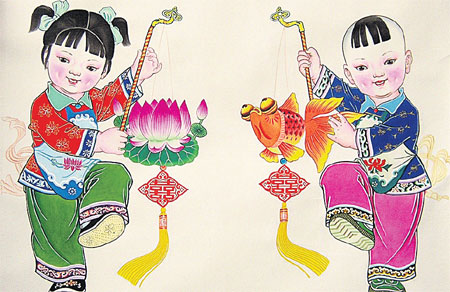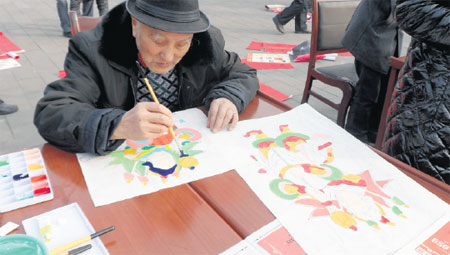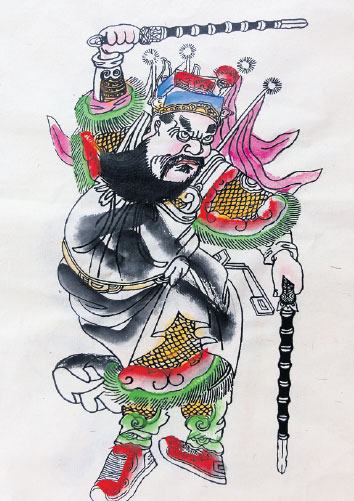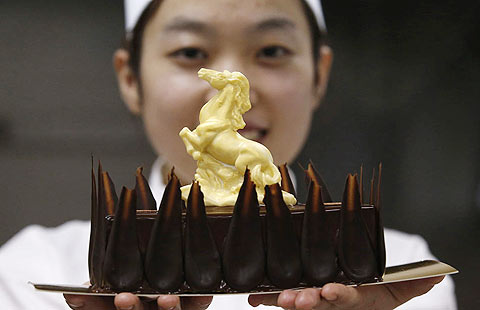Portraits of fortune
Updated: 2014-01-30 07:37
By Huang Zhiling (China Daily)
|
|||||||||||
Spring Festival is when Mianzhu Lunar New Year block prints trace the historical images of seasonal celebration in Sichuan province. Huang Zhiling reports in Mianzhu.
People like Li Fangfu give color to the Spring Festival. The holiday and its leadup is the busiest time for Lunar New Year block print artists. So the 84-year-old, who learned his trade from age 12, creates and sells the traditional paintings in the central square of Sichuan province's Mianzhu city from 8 am until 7 pm."This is what I'll do every day until the festival is over," he says. "Business is booming in the square."
The city's government is sponsoring the 13th Mianzhu Lunar New Year Block Print Festival until Feb 14 to brighten the holiday festivities. There are lanterns with block prints, tents belonging to artists like Li and the city's print museum is staging exhibitions.
Mianzhu is one of the four schools of the millennia-old Lunar New Year block print style. The others hail from Tianjin's Yangliuqing, Shandong province's Weifang and Suzhou's Taohuawu.
Mianzhu block prints have remained popular among rural areas for more than 1,000 years. They're adorned with auspicious symbols meant to coax fortune in the new year - harvests, rosy-cheeked toddlers bearing fish and door guardians.
Painters create Mianzhu prints by drawing a picture on paper fastened to wood as an outline for carving. Prints are produced when the raised surfaces are coated with ink and then pressed on paper to create image outlines.
What distinguishes Mianzhu from the other styles is that the pictures are then handpainted. This affords artists an opportunity to use their imaginations and experience, Li explains while painting a door guardian.
"Take this guardian for example," he explains.
"I apply purple. Another artist may use red. So images created with the same printing blocks can have different colors and personalities."
But all share the same theme.
Hou Shiwu, former director of the Mianzhu Lunar New Year Block Print Museum and a well-known print artist, says: "They all reflect hopes for happiness, fortune and longevity."
Mianzhu's Lunar New Year block prints debuted during the Tang Dynasty (AD 618-907) and flourished during the Qing Dynasty (1644-1911), when nearly 1,000 artists in more than 300 workshops produced as many as 12 million prints a year. The prints were sold to many parts of the country.
Part of the artistic legacy arises from Mianzhu's history as a bamboo paper-production area.
The city is named after the endemic bamboo species.
"In the Qing Dyansty, Mianzhu had more than 300 workshops that made good paper from bamboo," Hou explains.
Today, prints appear on postcards, calendars, fans and silk products.
Shejiantai village's Mianzhu Nanhuagong Lunar New Year Block Print Develoment Center has cooperated with a porcelain company in Jiangxi province's Jingdezhen to make porcelain ware with images popular in prints, says Li Jiao, the 26-year-old villager and print artist who became general manager of the center. She started dealing in prints six years ago.
The magnitude-8.0 Wenchuan earthquake on May 12, 2008, destroyed one-third of the houses in Shejiantai, which is known as "China's Lunar New Year Painting village". About 30 printmakers were unscathed.
The village has been reconstructed as a picture-perfect tourist attraction, where block print images adorn the 2,700 houses' exteriors.
The houses are built in traditional style with areas ranging from 200 to 400 square meters, village chief Xu Shipeng says.
The quake also damaged the Mianzhu Lunar New Year Block Print Museum, built with 5 million yuan ($819,672) in 1995. It's the only print museum aside from a smaller one in Yangliuqing.
Most exhibits survived and have moved to the new museum constructed after the disaster.
They include the most famous print Ushering in Spring made by Huang Ruihong (1865-1938) in the Qing Dynasty for local dye merchant Huang Gaozi.
The print depicts 460 people celebrating Spring Festival - officials, farmers pushing carts and women dangling fish.
Huang later sent the print to his accountant whose son sent it to the Sichuan Academy of Art in Chongqing in 1979 to seek a buyer. But prints weren't popular then.
Hou, the former museum curator, was studying at the academy and bought it for 80 yuan.
Today it is a priceless State-level cultural relic enjoying first-class protection that's hailed as Sichuan's version of the Riverside Scene at Qingming Festival - an ancient painting featuring more than 500 people created by Zhang Zeduan (1085-1145) that's among the country's most famous ancient artworks.
Contact the writer at huangzhiling@chinadaily.com.cn.
|
Mianzhu Lunar New Year block prints often feature auspicious symbols meant to coax fortune in the new year, such as rosy-cheeked toddlers bearing fish. Photos by Huang Zhiling / China Daily |
|
Li Fangfu paints on block prints in the central square of Mianzhu city. |
|
The door guardian is a traditional subject for Mianzhu block prints. |
(China Daily 01/30/2014 page18)
Today's Top News
London goes all-out to ring in Lunar New Year
Chinese family infected with H7N9
HK imposes sanction on Philippines
More Chinese set to travel overseas
Experts call for detailed H7N9 rules
Huawei pledges more jobs in Europe
HK confirms H7N9 case, to cull 20,000 poultry
Chinese President to visit Paris to boost ties
Hot Topics
Lunar probe , China growth forecasts, Emission rules get tougher, China seen through 'colored lens', International board,
Editor's Picks

|
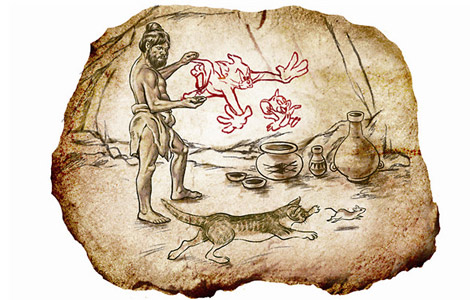
|

|

|

|

|
